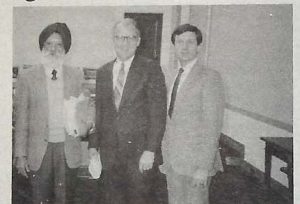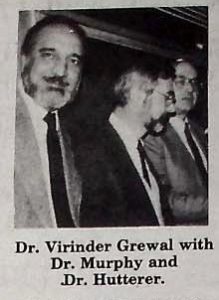

ANN ARBOR, Mi.: A two day conference was held on December 5 and 6 at the University of Michigan campus. The theme of the conference was “Guru Nanak and the Universalism in his teachings”. It was the third Annual Conference on Sikh Studies. The conference was organized by the Program in Sikh Studies in the Centre for South and Southeast Asian Studies.
Program in Sikh Studies is the beginning of the project that will shape into a full-fledged Chair in Sikh Studies. This program has been initiated with the efforts of Sikhs settled in various parts of the country and is being spearheaded by Dr. Virinder Singh Grewal, Dr. Satnam Singh Bhugra and S. Kuldeep Singh.
In his appeal for more funds, Dr. Grewal informed that the Sikhs were required to raise one million dollars for the Chair, Already a sum of one hundred thousand dollars had been deposited and there were pledges for three hundred fifty thousand dollars, He exhorted the Sikhs to donate generously and said that since the donations were tax deductible, an individual who donates 400 dollars actually pays only 80 dollars 4s $320 are tax deductible.
The conference was opened by welcome remarks by Dr. Rhoads Murphy, the new Director of the Centre for South and Southeast Asian Studies and Dr. Karl L. Hutterer, the outgoing Director in his introductory note briefly related the progress that the Sikh Studies Program had made and also referred to the increasing interest that the Western world was developing in the Sikh religion and the teachings of the Sikh Gurus.
The morning session on December 5 was devoted of the Context of Guru Nanak’s teachings. Dr, Rhoads Murphy acted as the Moderator and the first paper was read by Prof. Pritam Singh of Punjabi Sahit Academy on the subject: Gur Nanak’s Response to MultiReligious Society, He presented a graphic picture of Guru Nanak’s contemporary scene that was marked by diverse and often conflicting streams of religious thoughts, Besides the dichotomy between the two major religions, Hinduism and) Islam, the social milieu formed a crisscross of a Large number of smaller religious groups such a5 Shaivities, Vaishnays, Bhagats, Naths, Sufis, Sants etc. etc. Guru Nanak interacted with each one of them and gave his unique message to them without any acrimony or religious rivalry, Dr. Guninder Kaur of Colby College while describing Guru Nanak’s Vision of the Transcendent One explained how beautifully.
Guru Nanak had conveyed the ‘Omniscience, the timelessness, the indivisibility and the formlessness Of the Supreme Reality in the opening symbol of 9 which signified the indivisible unity of God and at the same time brought out the inadequacy of the alphabet also the geometry in comprehending God.
Talking about the concept of Advaita in GuruNanak’s writings, Dr. Rishpal Singh Aujal pointed ‘out that though some earlier traditions had acknowledged the oneness of God but it was GuruNanak alone who found complete unicity in God and His creation not only God was one but God and His whole creation was essentially one.
Prof. Prithipal Singh Kapur, ProViceChancellor, Guru Nanak Dev University, Amritsar, traced how Guru Nanak’s revelations had influenced the course of history, particularly the evolution of Sikh political power in Punjab.
The session after lunch was devoted to Guru Nanak and other Religions with Dr. Thomas Traut-man acting as the Moderator. Prof. Gurcharan Singh, formerly of Punjabi University, Patiala, while tracing Guru Nanak’s relations with the Sufi Saints emphasized that Sufi thought formed only one element of Guru Nanak’s all-encompassing vision.
Dr. Madanjit Kaur, G.N.D. University, Amritsar, in an exhaustive paper explained Guru Nanak’s philosophy in the context of Indian Religious thought and pointed out that Guru Nanak’s message was for mankind as a whole as he recognized human beings as also rest of God’s creation as one. There were no Muslims and no Hindus. All were God’s children and must be treated as such.
Prof. M.S. Sidhu, Editor World Sikh News, in his paper on Guru Nanak: A Study in Self-abnegation Self elevation, while expressing pain at the motivated attempts to project Guru Nanak as a Hindu reformer, pointed out that Sikh religion was essentially a revelatory movement and not an extension of any older religion. For Guru Nanak, this world was real and he looked upon it as a beautiful manifestation of God, Whereas man is required to immerse his being, his self or ego in Simran, he is also required to use the divine spark within him in the service of mankind, Man is not to escape from his social obligations but must endeavor to uphold the moral law. Morality and spirituality go together. Injustice and oppression are to be opposed. Rather than suffering a slavish existence, man ‘must aspire and struggle for a life of dignity and freedom.
Dr. Ranbir Singh Sandhu while tracing the Relationship of the Sikh Religion to other Faiths, extensively quoted from Guru Granth Sahib to establish that Sikhism did not fault any other. He also pointed out that Sikhism is not a conscious attempt at any kind of synthesis of different religious traditions. It was original, independent and revelatory. He criticized Dr. McLeod for evolving utterly baseless theories.
The morning session on December 6 was devoted to Guru Nanak’s teachings and its Contemporary Relevance. Dr. Hutterer Moderated the session. Prof. Iqbal Singh of Duke University brought out the simplicity in Guru Nanak’s conception of life and living. Guru Nanak’s explanation of life and its origin is precisely what the scientists have subsequently described as the Big bang theory. First there was nothing except the Timeless and everything came out of the Timeless. In living, Guru Nanak gave a very simple formula of Nam Japo (meditate on God’s name), Vund Chhako (share your earnings with others) and Kirat Karo (earn your bread by the sweat of thy brow).
Prof. B.S. Madan made a comparative study of Guru Nanak’s message in relation to Judaism and Christianity, in the context of its place and relevance in the modern world.
Article extracted from this publication >> December 11, 1987